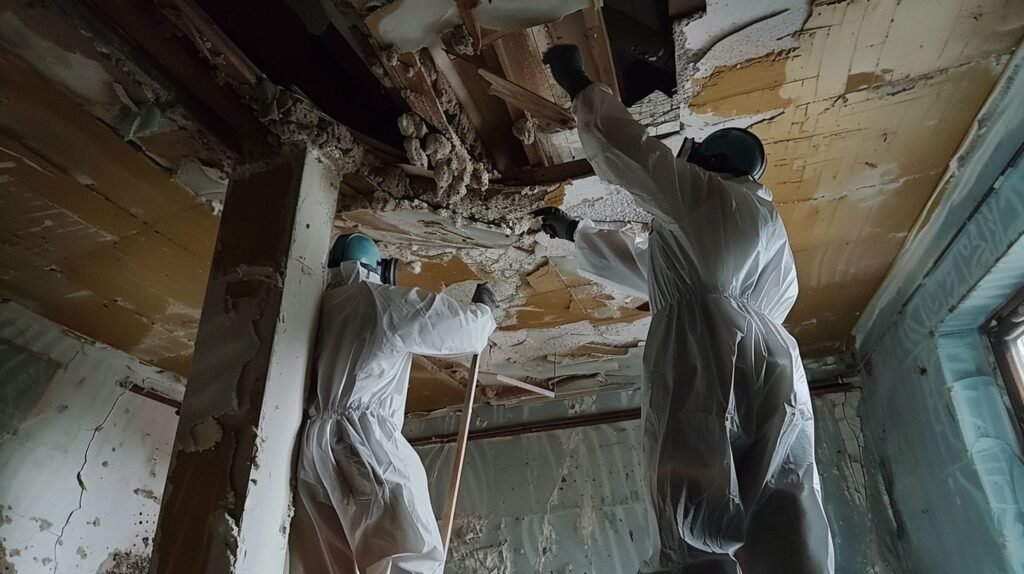Asbestos, once widely used in construction for its heat-resistant and insulating properties, has been identified as a hazardous material that can cause severe health issues when its fibers become airborne and are inhaled. These health risks include lung cancer, mesothelioma, and asbestosis. Because of this, strict safety protocols must be followed during asbestos surveys to protect workers, building occupants, and the environment. One critical component of personal protective equipment (PPE) used during these surveys is disposable coveralls.

Understanding Asbestos Surveys
An asbestos survey is a comprehensive inspection of a building to locate, assess, and record the presence and condition of any asbestos-containing materials (ACMs). These surveys are typically required before any major renovation or demolition work is carried out, especially in buildings constructed before the 1980s when asbestos use was more prevalent.
There are two main types of asbestos surveys:
- Management Survey – This is a standard survey designed to locate and assess ACMs that may be present and manage their condition while the building remains in normal use.
- Refurbishment and Demolition Survey – A more intrusive survey conducted prior to any significant renovation or demolition work. It aims to identify all ACMs that could be disturbed during such activities.
The level of risk associated with each type of survey determines the necessary PPE, including whether disposable coveralls should be worn.
When Are Disposable Coveralls Required?
Disposable coveralls should be worn whenever there is a potential for exposure to asbestos fibers. The primary purpose of wearing disposable coveralls during an asbestos survey is to prevent contamination of personal clothing and skin, reduce the risk of carrying asbestos fibers away from the site, and ensure compliance with health and safety regulations.
Key Situations When Disposable Coveralls Should Be Worn:
1. During Refurbishment and Demolition Surveys
- These surveys are highly intrusive and often involve breaking into walls, ceilings, and other structures where ACMs may be hidden.
- Since the likelihood of disturbing asbestos fibers is high, disposable coveralls are mandatory.
- These coveralls should be of Type 5 or Type 6 protection, offering resistance against particulates and limited liquid exposure.
2. When Suspected Asbestos-Containing Materials Are Present
- Even if ACM status has not yet been confirmed, it’s prudent to assume materials contain asbestos until proven otherwise.
- In such cases, disposable coveralls should be worn as a precautionary measure to protect the surveyor and prevent cross-contamination.
3. In Confined or Poorly Ventilated Spaces
- Enclosed areas like basements, attics, or ventilation shafts may have higher concentrations of airborne asbestos fibers.
- Wearing disposable coveralls in addition to respiratory protection becomes essential in these environments.
4. During Sampling of Suspect Materials
- Although management surveys are non-intrusive, sampling still involves cutting or disturbing materials to obtain samples.
- Any disturbance, no matter how minor, can release fibers into the air.
- Therefore, disposable coveralls should always be worn during sampling procedures.
5. When Working in Known Asbestos-Contaminated Areas
- If previous surveys have confirmed the presence of ACMs in a specific area, even if they are currently undisturbed, the area should be treated as contaminated.
- Surveyors entering such zones must wear full PPE, including disposable coveralls.
Choosing the Right Disposable Coveralls
Not all disposable coveralls offer the same level of protection. It’s important to select coveralls appropriate for the task and the level of risk involved. Common classifications include:
- Type 1: Fully encapsulating chemical protective suits (not typically needed for standard asbestos surveys).
- Type 3: Protection against liquid jets (used in high-risk scenarios involving possible liquid contamination).
- Type 4: Protection against liquid splashes.
- Type 5: Protection against solid particulates (ideal for asbestos fiber protection).
- Type 6: Limited protection against light liquid splashes.
For most asbestos surveying tasks, Type 5 coveralls are recommended, as they are designed to protect against fine particles like asbestos fibers.
Additionally, coveralls should be combined with other PPE components:
- Respiratory Protection: Class P3 disposable respirators or powered air-purifying respirators (PAPRs) depending on the risk level.
- Gloves and Footwear Covers: To provide full-body protection.
- Eye Protection: Safety goggles or face shields to prevent fiber entry through mucous membranes.
Proper Use and Disposal of Disposable Coveralls
Wearing disposable coveralls is only effective if done correctly:
- Donning (Putting On): Ensure coveralls are put on without contaminating the inside. Avoid touching the outside surface once dressed.
- During Use: Minimize contact with surfaces and avoid actions that could stir up dust or damage the suit.
- Doffing (Taking Off): Remove coveralls carefully to avoid shaking or spreading fibers. Assistance is often required to ensure safe removal.
- Disposal: Used coveralls must be disposed of as hazardous waste following local regulations. They should be sealed in labeled, leak-tight bags or containers marked for asbestos waste.
Legal and Regulatory Considerations
Many countries have established legal frameworks governing asbestos handling, which include requirements for PPE. For example:
- In the United States, OSHA’s asbestos standards (29 CFR 1910.1001) mandate the use of protective clothing in asbestos-regulated areas.
- In the UK, the Control of Asbestos Regulations 2012 requires employers to provide suitable PPE, including disposable coveralls, to anyone who may be exposed to asbestos.
- Similar regulations exist across Europe, Australia, Canada, and other regions.
Failure to comply with these regulations can result in serious penalties, legal action, and increased health risks.
Disposable coveralls play a vital role in protecting surveyors during asbestos inspections. While the necessity of wearing them may vary depending on the survey type and conditions, erring on the side of caution is always advised. Whether conducting a routine management survey or a high-risk refurbishment survey, disposable coveralls should be considered essential PPE when dealing with asbestos. By understanding when and how to use them properly, professionals can significantly reduce the risk of asbestos exposure and ensure compliance with health and safety laws.


